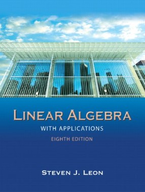Let S, T, and U be subspaces of a vector space V. We can form new subspaces by using the
Chapter 3, Problem 23(choose chapter or problem)
Let S, T, and U be subspaces of a vector space V. We can form new subspaces by using the operations of and + defined in Exercises 20 and 22. When we do arithmetic with numbers, we know that the operation of multiplication distributes over the operation of addition in the sense that a(b + c) = ab + ac It is natural to ask whether similar distributive laws hold for the two operations with subspaces. (a) Does the intersection operation for subspaces distribute over the addition operation? That is, does S (T + U) = (S T ) + (S U) (b) Does the addition operation for subspaces distribute over the intersection operation? That is, does S + (T U) = (S + T ) (S + U)
Unfortunately, we don't have that question answered yet. But you can get it answered in just 5 hours by Logging in or Becoming a subscriber.
Becoming a subscriber
Or look for another answer
